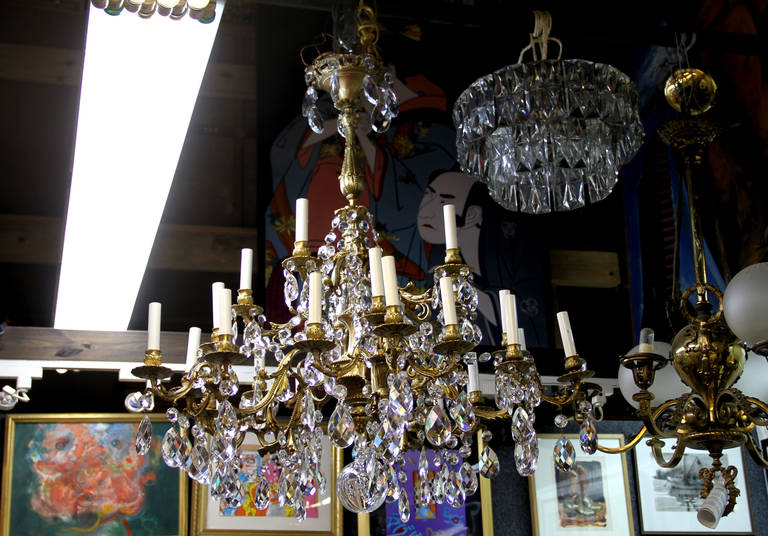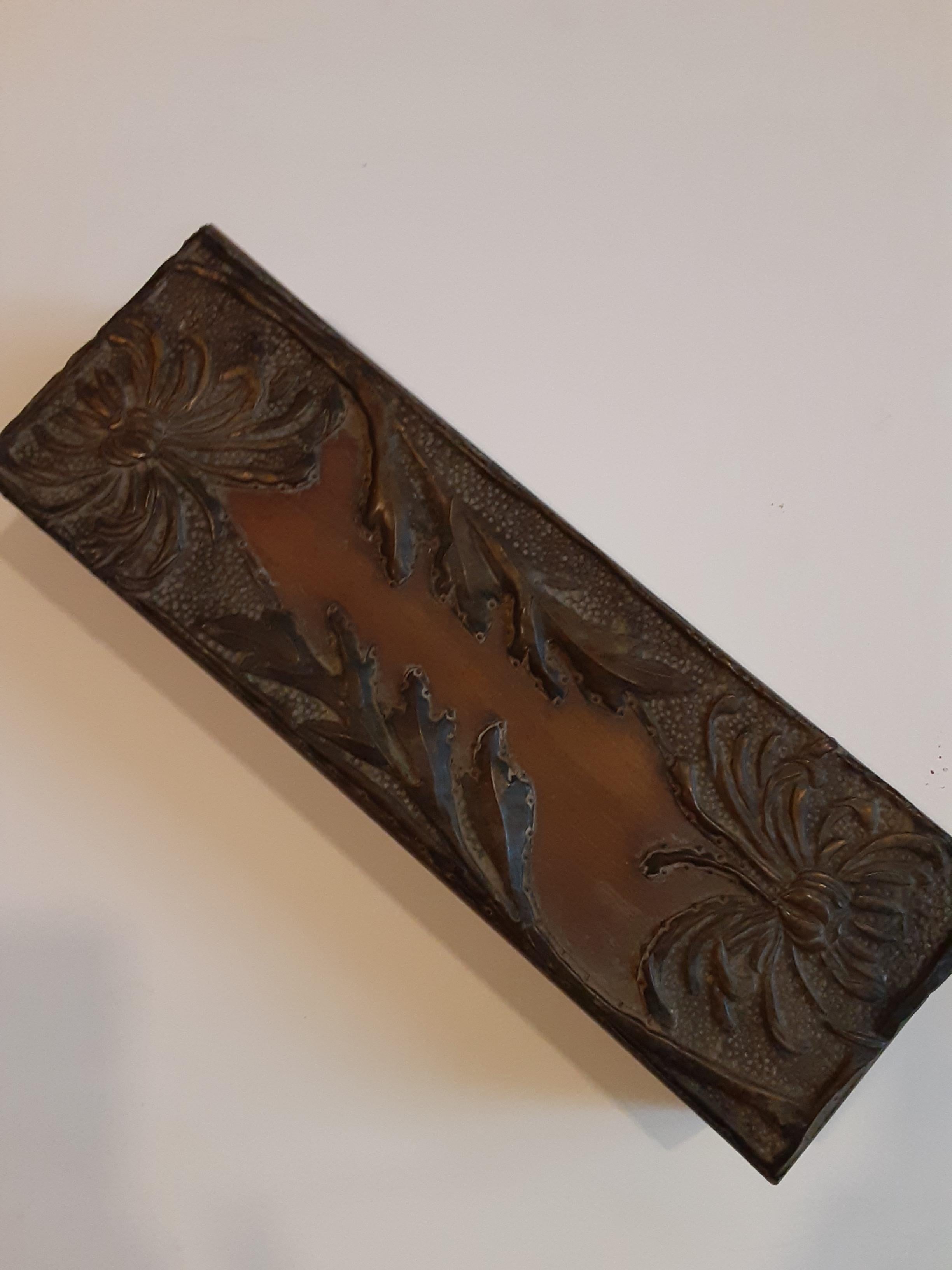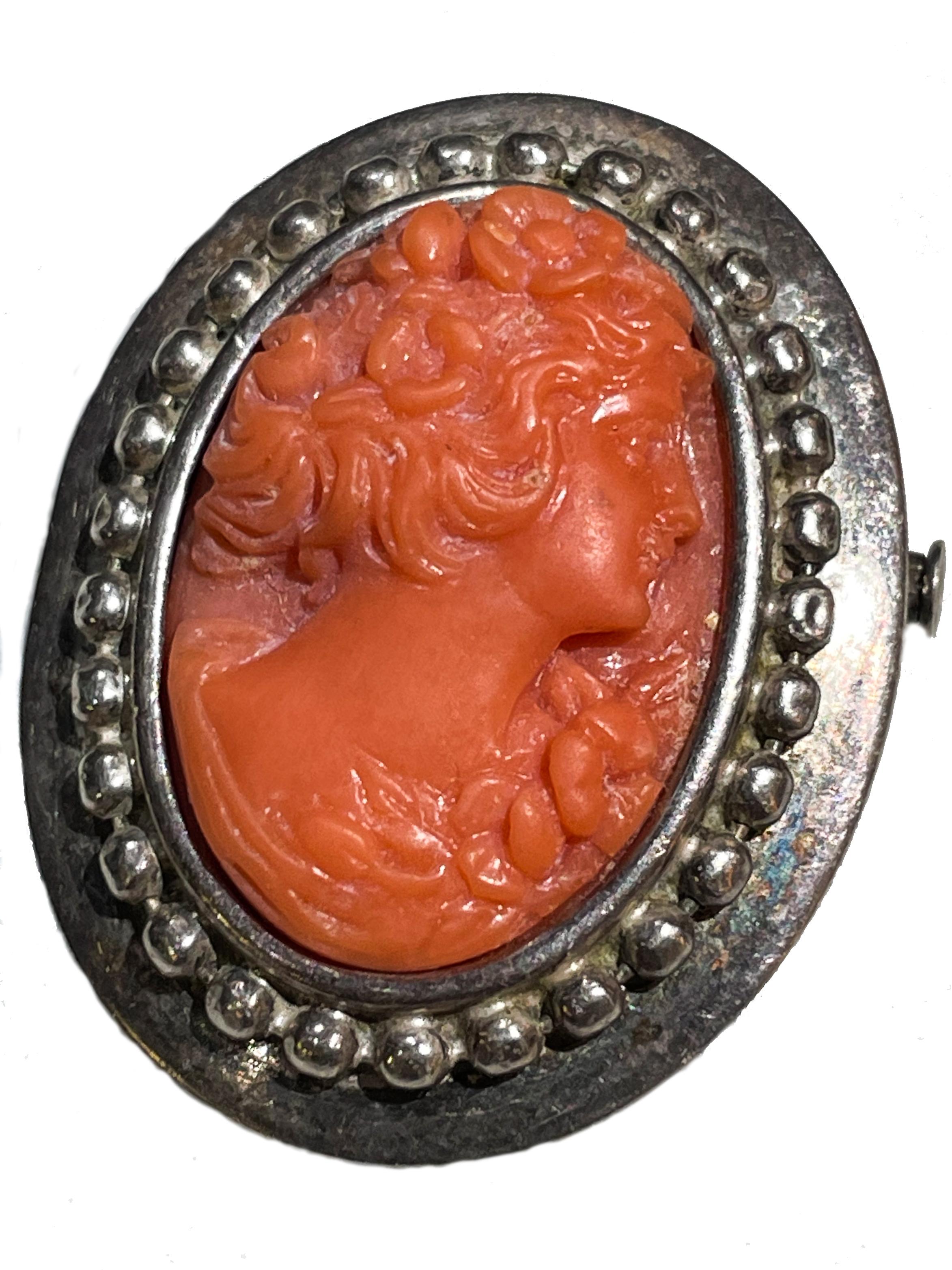Items Similar to Rare Early 20th C Bezalel Silverplate Repousse Judaica Menorah Made in Palestine
Want more images or videos?
Request additional images or videos from the seller
1 of 9
Zeev RabanRare Early 20th C Bezalel Silverplate Repousse Judaica Menorah Made in Palestine
About the Item
For standing on feet or as a wall hanging with a hole at the top for mounting on the wall. Original Bezalel School brass bronze menorah with the original silverplate intact. Including the servant light Shammash (which is more rare) and having all 8 cups. all four feet are intact (although very slightly bent from use), which is noteworthy, as when this menorah appears at auction, the feet tend to be missing as they are easily detached. Backplate is a design of the Holy Temple Menorah lighting by the high priest and a Ze'ev Raban design, similar examples are illustrated in the book "Raban Remembered Jerusalem's Bezalel School
The Bezalel Academy of Arts and Design, was founded in 1906 by Boris Schatz. In 1903, Schatz met Theodore Herzl and became an ardent Zionist. At the Zionist Congress of 1905, he proposed the idea of an art school in the Yishuv (early Jewish settlements), and in 1906 he moved to British Mandate Palestine, later Israel and founded the Bezalel School of Art in Jerusalem. Bezalel, which was a school for crafts as well as for graphic art, became successful very rapidly. Schatz’s vision was to develop useful judaic arts and crafts among Palestinian Jews, thereby decreasing the dependence on charity. At the same time, he sought to inspire his students to create a Jewish national style of the arts, in order to promote the Zionist endeavor. The inhabitants of 19th-century Palestine, both Jewish and non-Jewish, had produced mostly folk art, ritual objects and olive-wood and shell-work souvenirs, so the founding of Bezalel provided a professional and ideological framework for the arts and crafts in Jerusalem. The school employed workers and students, of whom there were 450 in 1913, in manufacturing, chiefly for export, decorative articles ranging from cane furniture, inlaid frames and ivory and wood carvings, to damascene and silver filigree and repousse work.
A major part of Schatz’s school was the workshops, which, starting with rug-making and silversmithing, eventually offered 30 different crafts. Workshops included the "Menorah" workshop where they designed relief and souvenirs made of terra-Cotta, and the Sharar, Stanetsky and Alfred Salzmann workshops where Menorah lamps, candlesticks, brass plates for Passover, and many other ceremonial and souvenir items were made.
Intended to create an original national style, Bezalel artifacts were a
mixture of oriental styles and techniques with Art Nouveau features, art deco styles and influences from the Arts and Crafts Movement.
The Academy reopened after Schatz's death in 1935 led by the new director, Joseph Budko, who took advantage of the many new European immigrants' talent and energy and succeeded in revitalizing the school. In the mid 1930's, Bezalel was reestablished by German and European refugee artists driven to Palestine by the Nazis, and underwent a final reorganization in 1965 that established Bezalel as a school for crafts. A small museum was added to the school which became the foundation for the Bezalel Museum
later to become the world famous Israel Museum. Bezalel strove to foster in its students a national style of art, drawing both from European
techniques and Near Eastern art forms. While centers of Jewish art could be found elsewhere early in the 20th century (such as the school of Yehuda Pen in Vitebsk where Marc Chagall had studied) these were even more short lived. Bezalel subjects were a combination of traditional Jewish religious images, Zionist symbols, Biblical themes, views of the Holy Land and depictions of the flora and fauna of Palestine.
Artists at the Bezalel School used holy places, female figures and the beautiful landscapes of the holy land in their work.
Zev Raban, a major Bezalel artist, also designed products for various artistic cooperatives that were under the control of Bezalel: for Moshe Murro, Bezalel amulet artist, Raban designed many items, later executed in metal and ivory. For the famous Bezalel Yemenite jeweler- Yichieh Yemini, Raban designed many jewelries and Filigree works. Renowned Bezalel School artists include Meir Gur Arieh, Zev Raban, Jacob Eisenberg, Joseph Budko Jacob Steinhardt, and Hermann Struck.
- Creator:Zeev Raban (1890 - 1970, Israeli)
- Dimensions:Height: 6.5 in (16.51 cm)Width: 8.5 in (21.59 cm)Depth: 2 in (5.08 cm)
- Medium:
- Movement & Style:
- Period:
- Condition:
- Gallery Location:Surfside, FL
- Reference Number:1stDibs: LU38214286752
About the Seller
4.9
Platinum Seller
These expertly vetted sellers are 1stDibs' most experienced sellers and are rated highest by our customers.
Established in 1995
1stDibs seller since 2014
1,548 sales on 1stDibs
Typical response time: 1 hour
- ShippingRetrieving quote...Ships From: Surfside, FL
- Return PolicyA return for this item may be initiated within 3 days of delivery.
More From This SellerView All
- Rare Judaica Chevron Bezalel Zeev Raban Chromolithograph (made in Palestine)By Zeev RabanLocated in Surfside, FLJerusalem's Bezalel School The Bezalel Academy of Arts and Design, was founded in 1906 by Boris Schatz. In 1903, Schatz met Theodore Herzl and became an ardent Zionist. At the Zionis...Category
Early 20th Century Art Nouveau More Art
MaterialsLithograph
- Bezalel School Jerusalem, Middle Eastern Arab Man in Turban Circa 1920s EtchingBy Jacob EisenbergLocated in Surfside, FLGenre: Realism Subject: Portrait Medium: Etching Surface: Paper Country: Israel Dimensions with Frame: 18" x 114" Jacob Eisenberg (1897–1965) (also Yaakov Eisenberg) was an Israeli ...Category
1920s Art Nouveau Portrait Prints
MaterialsEtching
- Vintage 1971 Jewish Film Festival Poster Berkeley EM Lilien Art Nouveau JudaicaLocated in Surfside, FLThis is printed on heavy art paper. it is a lithograph or silkscreen print done after a drawing by Ephraim Moshe Lilien. Great vintage judaic art from Berkeley California in the 1970's. Ephraim Moses Lilien (Hebrew: אפרים משה ליליין; 23 May 1874 – 18 July 1925) was an art nouveau illustrator and printmaker particularly noted for his art on Jewish themes. He is sometimes called the "first Zionist artist." Ephraim Moses Lilien (Maurycy Lilien) was born in 1874, in Drohobycz, Galicia, then in the Austro-Hungarian Empire. In 1889-1893 Lilien learned painting and graphic techniques at the Academy of Arts in Kraków. He studied under Polish painter Jan Matejko from 1890 to 1892. As a member of the Zionist Movement, Lilien traveled to Ottoman Palestine several times between 1906 and 1918. Lilien attended the Fifth Zionist Congress, held in Basel, as a member of the Democratic Fraction, an opposition group that supported the development of secular national culture. In 1905, at the Seventh Zionist Congress, in Basel, he, along with Boris Schatz, became a member of a committee formed to help establish the Bezalel Art School. As part of that work he accompanied Schatz to Jerusalem. Lilien was one of the two artists to accompany Boris Schatz to what is now Israel in 1906 for the purpose of establishing Bezalel Academy of Arts and Design, and taught the school's first class in 1906. Although his stay in the country was short-lived, he left his indelible stamp on the creation of an Eretz Israel style, placing biblical subjects in the Zionist context and oriental settings, conceived in an idealized Western design. In the first two decades of the century, Lilien's work served as a model for the Bezalel group. Lilien is known for his famous photographic portrait of Theodor Herzl. He often used Herzl as a model, considering his features a perfect representation of the "New Jew." In 1896, he received an award for photography from the avant garde magazine Jugend. Lilien illustrated several books. In 1923, an exhibition of his work opened in New York. Lilien's illustrated books include Juda (1900), Biblically-themes poetry by Lilien's Christian friend, Börries Freiherr von Münchhausen, and Lieder des Ghetto (Songs of the Ghetto) (1903), Yiddish poems by Morris Rosenfeld...Category
1970s Art Nouveau Prints and Multiples
MaterialsLithograph
- Abstract 3D Wall Hanging Sculpture Brad Howe LA Artist Laser Cut Steel Pop ArtBy Brad HoweLocated in Surfside, FLLetters and numbers cut from a sheet of brushed steel. Hand signed and dated Brad Howe (born 1959) is an American sculptor from California. His work has been exhibited domestically and internationally. This is done in a bold and colorful Pop Art style reminiscent of the work of the Memphis Milano Group. Brad Howe was born in 1959 in Riverside, California. As a student of International Relations at Stanford University, Howe attended the University of São Paulo to specialize in Literature and Economic History. It was there that he discovered his passion for art and architecture that would eventually lead to his first exhibitions. He started his career as a sculptor in Brazil, using stainless steel, aluminum and polyurethane. He credits sculptor Alexander Calder as an early influence in his work. Since then, he has exhibited in over eighteen countries worldwide and his works have been placed in collections in more than 32 countries, including Brazil, Mexico, France, Germany, South Korea and United States. His work can also be found at various universities including Massachusetts Institute of Technology (MIT) in Boston, Temple University in Philadelphia, and UCLA. Monumental and Public Art have become a major focus of his career. Over the past ten years, he has completed over 30 public projects in 7 different countries. One of his sculptures can be seen in the city of Palo Alto, California. Moreover, as part of the Beverly Hills Centennial Arts of Palm Installation, he designed four sculptures outside the Beverly Hills City Hall, on North Santa Monica Boulevard in Beverly Hills, California. The Crocker Art Museum (Sacramento, California), the Honolulu Museum of Art, the Lancaster Museum of Art and History (Lancaster, California), and the Pasadena Museum of California Art (Pasadena, California) are among the museums holding work by Brad Howe. His work was included in the Arts of Palm exhibition in Beverly Hills, palm trees by prominent artists including Brad Howe, Michael McMillen, Mike Stilkey, Peter Shire, Peter Alexander and Ryan Schmidt...Category
1990s Pop Art Abstract Sculptures
MaterialsMetal
- Large Hand Painted Abstract Ceramic Platter Stamped Madoura Plein Feu BrutalistLocated in Surfside, FLLarge Madoura Pottery Ceramic Platter Stamped "MADOURA PLEIN FEU" This is not marked Picasso. It is an early piece. i am uncertain who the artist is. It app...Category
Mid-20th Century Modern Abstract Sculptures
MaterialsEnamel
- Rare Antique Enamel Singer Sewing Machine Sign - HebrewLocated in Surfside, FLRare antique enamel Vintage Singer Sewing Machine advertisement Sign in Hebrew or Yiddish. Please see photos for condition. Rare early Je...Category
20th Century More Art
MaterialsEnamel
You May Also Like
- French Crystal Bronze Chandelier ca. 1910Located in Long Island City, NYThis gorgeous chandelier is from circa 1910 with 24 candle bulbs an a multitude of gemini cut crystal. Believed to be French in origin, and will be stunning in any space. Has been re...Category
1910s Art Nouveau More Art
MaterialsBronze
- Art Nouveau European BoxLocated in Troy, NYThis elegant Art Nouveau box was originally made in France circa. 1910, and remains in very good condition. It was acquired from a French estate. The lid of the box is decorated with...Category
1910s Art Nouveau Still-life Sculptures
MaterialsMetal, Bronze
- Coral Brooche. Early 20th century Italian Cameo with woman profile.Located in Firenze, ITFREE SHIPPING WORLDWIDE Early 20th century Italian cameo with woman profile. Hand carved cameo. Dimensions: H 3.5cm x W 3cm Italian manufactory of early 20th century. Probably ...Category
Mid-20th Century Art Nouveau More Art
MaterialsSilver
- XIX century. A jeweled bow with tassels, in low gold. Neapolitan area.Located in Firenze, ITXIX century. A jeweled bow with tassels, in low gold. Neapolitan area. The jewel is a pendant, with a ring positioned on the back that allows you to pass a necklace even of a not sma...Category
Late 19th Century Art Nouveau More Art
MaterialsGold
- Pomme Bouche, Brooch, Claude Lalanne, French, Design, 1990's, Bronze, JewelsBy Claude LalanneLocated in Geneva, CHPomme Bouche, Brooch, Claude Lalanne, French, Design, 1990's, Bronze, Jewels Brooch Pomme Bouche 1990 Edition Arthus-bertrand, Paris Bronze with a golden...Category
1990s Art Nouveau Abstract Sculptures
MaterialsBronze
- Cufflinks Red Gold Flower Vintage Black Porcelain Jewelry Men (MADE TO ORDER)By Melanie ShermanLocated in Kansas City, MOMelanie Sherman Cufflinks with Red & Gold Flowers on Black Porcelain Dimensions: 20mm x 17mm x 17mm Materials: Porcelain, Glaze, Vintage Decal Metal type: Brass COA Provided * These pieces are made to order any may exceed the 10 Day Shipping time frame Melanie Sherman is a ceramic artist, born in Germany and currently residing and working in Kansas City, Missouri. She has a Bachelor of Fine Arts Degree in ceramics from the Kansas City Art Institute. Her background is in graphic design, where she developed an eye for pattern and decoration. In her ceramics she combines her love for ornamentation and her fascination with the history of ceramics, referencing 18th century European porcelain...Category
2010s Art Nouveau More Art
MaterialsGold, Brass





